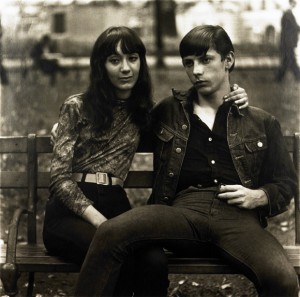
Diane Arbus: “Young Couple on a Bench”, 1965. 15 13/16 x 19½ inches. Edition 8/75. Gift of C. Jane Hurley Wilson ’64 and Michael G. Wilson.
Diane Arbus found people who transgressed societal norms to be the subjects most worth photographing. Her mysterious and captivating photographs, set in New York City during the 1950s and ’60s, tend to explore the human experience of people whose lives existed on the edge of social acceptance, including circus performers, giants, midgets, transvestites, and eccentrics. Arbus’ photographs were controversial pieces at the time and continue to bring into question the voyeuristic and exploitative aspects of photography.
Born in 1923 to a wealthy Jewish family in New York City, Diane Arbus was able to take advantage of the city’s diverse and eccentric subcultures. She began her exploration of photography in 1941 at the age of eighteen when she married Allen Arbus. In the fifties, Allen and Diane Arbus collaboratively worked as fashion photographers, working for Vogue and Glamour, as well as several advertising agencies.
Highly impressed by the reputable photographer, Lisette Model, Diane Arbus enrolled at the New School in New York City at the age of thirty-five in order to take a course being taught by Model. With the encouragement of her teacher, Arbus gained the confidence necessary to document the people and places that she was simultaneously fascinated by and afraid of. Her subject matter and style became more specific, capturing the “androgynous, the crippled, the deformed, the dead, the dying, she never looked away, which took courage and independence”, as Model described.1
Lisette Model often emphasized to her students the importance of a connection between photographer and subject- “it can be a confrontation, a conversation, an occasion fraught with emotion, but some sort of visceral exchange is necessary and crucial to make the photograph valid”.2 It is evident that Diane Arbus explored this reciprocated exchange that occurs with the subject as her photographs shifted from distanced photographs to close-up portraits.
Arbus often established connections between the strangers whose portraits she chose to capture. Visiting their homes and learning about their private lives, Arbus still managed to include a mysterious aspect in all of her photographs that make the viewer wish to engage with the subject in the same manner that Arbus did.
Her photographs have a distinctive, direct style and, though they explore the theme of “otherness” in society, the viewer does not take on the role voyeur, due to the directness of the gaze of the subject. There is a sense of openness and intimacy present in her photographs that counteracts the claim that her photography is exploitative of her subjects.
This mysterious yet direct style is evident in Young Couple on a Bench. The photograph captures a young woman staring directly at the camera while the young man seated next to her looks away nonchalantly. They both have equally bleak expressions, which present visual ambiguity for the viewer. Although the photograph does not specifically belong to a series, it can easily be included with the numerous photographs that Diane Arbus took in Washington Square Park. Arbus also enjoyed taking portraits of couples: young couples, unmarried couples, and transvestite couples. Even though the couple in this photograph appears to be a man and a woman, their androgynous features make the viewer question whether or not it may be a trans-gendered couple.
Diane Arbus was a pivotal figure of photography who continuously questioned what we consider to be permissible subject matter. In 1963 and 1966, she was awarded Guggenheim Fellowships. In 1972, the year following her tragic death, Arbus became the first American photographer to be represented at the Venice Biennale. A retrospective of her work was exhibited at the Museum of Modern Art, which then traveled throughout both the United States and Canada. Diane Arbus continues to be an important female figure in documentary photography and her work continues to bring into question the boundaries of photography.
References
- Bosworth, Patricia. Diane Arbus. New York: W.W Norton & Company, 2005, p.132.
- Ibid., p.130.
Written by Amy Vasquez (SC ’09) 2008-2009 Wilson Intern.

